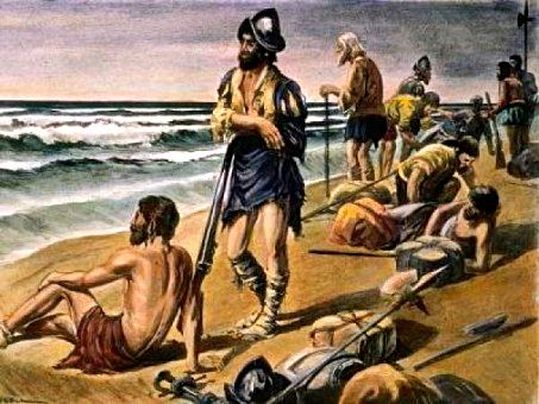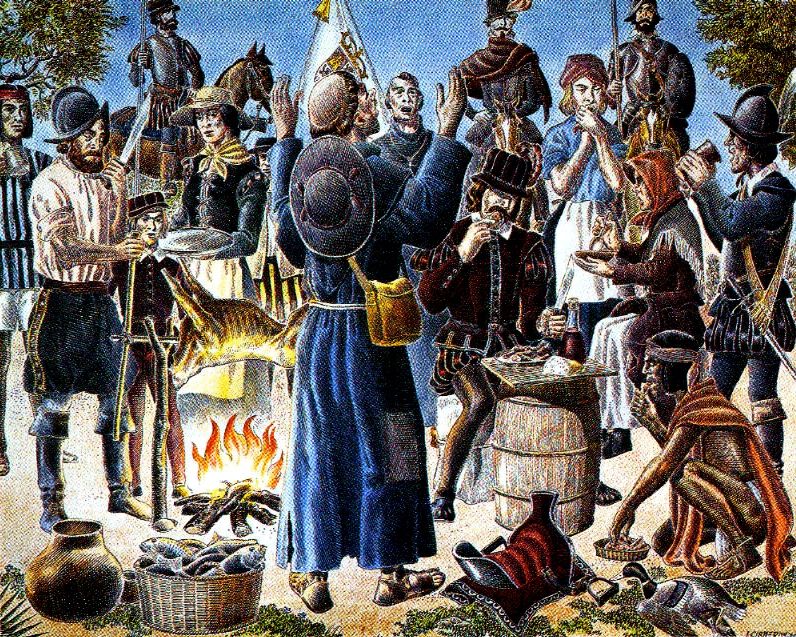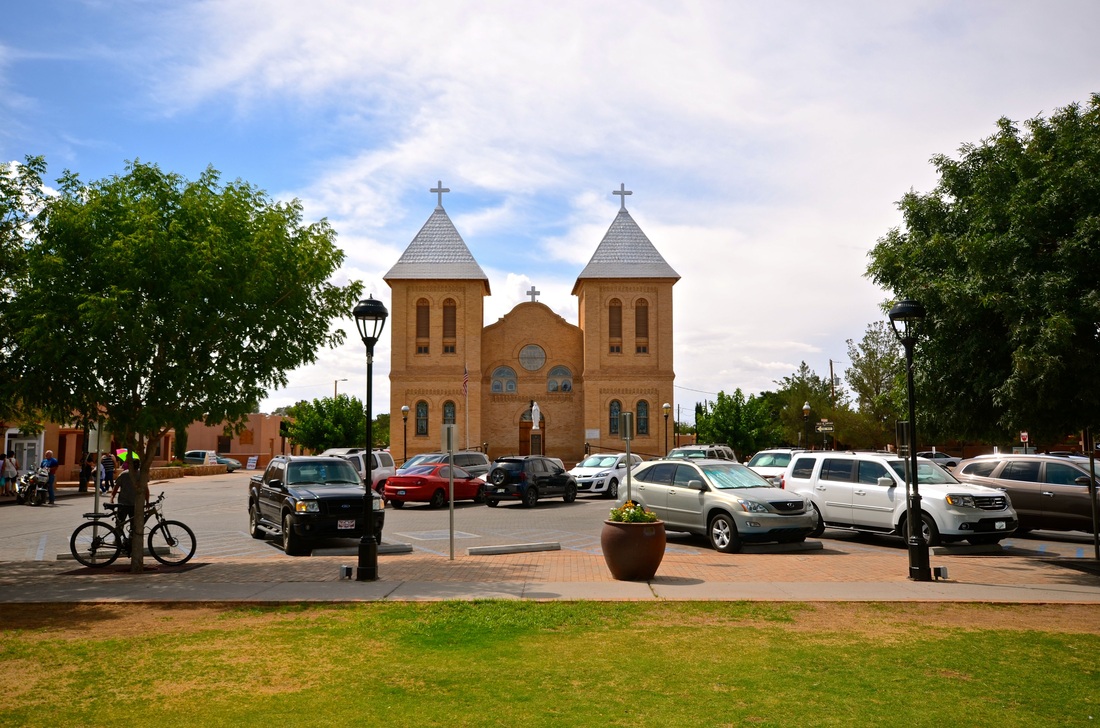HOP ABOARD! The Great Hispanic American History Tour
|
´SUBA A BORDO!
|
|
|
|
|
1. The Great Hispanic American
|
2. On the Trail of ConquistadorsJune 24, 2014 -- From the water, you still can see small sections of unspoiled shoreline that allow you to imagine what the conquistadors must have seen when they landed on the west coast of Florida almost 500 years ago. Seeking that vantage point, from the intercostal waterways near St. Petersburg, Florida, I discovered last week that you still can land on the same spot where Panfilo de Narvaez began his exploration of North America in 1528. (49) Read more -->
2. En el Camino de los Conquistadores24 de junio de 2014 -- Desde el mar, todavía se logra ver pequeñas secciones de una impecable costa donde se puede imaginar lo que los conquistadores vieron al llegar a la orilla oeste de Florida hace casi 500 años. Buscando esa vista única, desde el canal intercostal cerca de St. Petersburg, Florida, descubrí la semana pasada que todavía se puede desembarcar en el mismo lugar donde Pánfilo de Narváez comenzó su exploración de Norteamérica en 1528. (49) Lea mas -->
|
3. Beyond St. AugustineJuly 1, 2014 - To follow the footsteps of the Spanish conquistadors who came to North America some 500 years ago, sometimes water routes are necessary. And that's how I found myself rowing on the Econfina Creek in northwest Florida. After seeing how the Panfilo de Narvaez expedition reached Florida in 1528 — from a modern deck boat that landed in St. Petersburg — I also wanted to see how some of its survivors escaped Florida and the arrows of its natives, this time from the perspective of a canoe! (50) Read more -->
3. Más Allá de San Agustín1 de julio de 2014 - Para seguir los pasos de los conquistadores españoles que vinieron a Norte América hace unos 500 años, a veces las rutas marinas son necesarias. Y fue así que me encontré en Econfina Creek (Arroyo Econfina) en el noroeste de Florida. Después de ver como la expedición de Pánfilo de Narváez llegó a Florida en 1528 — desde un bote moderno que arribó en San Petersburg — también quería ver como algunos de sus sobrevivientes escaparon de Florida y de las flechas de los indígenas, esta vez desde la perspectiva de una canoa. (50) Lea mas -->
|
4. A Hidden Hispanic Role ModelJuly 8, 2014 -- When you stand next to those huge cannons pointing into Mobile Bay, as I did when I recently visited Fort Gaines and Fort Morgan in Alabama, somehow they don't look as menacing as when you see them from the water, as I did when I took the ferry that crosses the mouth of that huge bay. In my quest to rediscover America's hidden Hispanic heritage, I sought the perspective of the Union Navy and the Hispanic commander who led them to victory in the Battle of Mobile Bay 150 years ago during the Civil War. (51) Read more -->
4. Un Modelo Hispano Oculto8 de julio de 2014 -- Cuando estás parado al lado de esos enormes cañones apuntando hacia la bahía de Mobile, como lo hice cuando recientemente visité Fort Gaines y Fort Morgan en Alabama, por alguna razón no se ven tan amenazantes como cuando usted los ve desde el agua, como lo hice cuando tome el ferry que cruza la boca de esa enorme bahía. (51) Lea mas -->
|
5. The Hispanic Flank
|
6. New Orleans Has a Spanish 'Ne Sais Quoi'July 22, 2014 - You feel like you've been there before, and yet you know this is your first time in New Orleans. That's the sensation you get if you are a Latino arriving in the French Quarter. At first you can't quite figure out why everything looks so familiar. You are expecting the French Quarter to be more French! (53) Read more -->
|
7. Galveston: Still the Isle Of Misfortune?July 29, 2014 - As if the day had been made to order, just for me to truly appreciate the hardships endured by Álvar Núñez Cabeza de Vaca and a few-dozen other shipwrecked Spanish conquistadors almost 500 years ago, there was menacing weather when I arrived on Isla de Mahaldo — the Isle of Misfortune. Nowadays they call it Galveston Island, Texas, but I could clearly see why the Spanish gave it its former name. (54) Read more -->
|
8. Extracting Compacted History Unveils Hidden Hispanic HeritageAugust 5, 2014 - We all make the same mistake. When traveling through history, we tend to shorten time and lose perspective, often turning centuries into decades and decades into years. Perhaps this is the reason why so many Americans still confuse the totally justified Texas War of Independence from Mexico and the totally unjustified Mexican-American War almost a decade later... (55) Read more -->
|
9. 'Remember the Alamo'
|
10. San Antonio: The Showcase of Our Hispanic HeritageAugust 19, 2014 - In the early evening, as I walked through Main Plaza in downtown San Antonio, headed by the majestic San Fernando Cathedral and reminiscent of the many Spanish colonial plazas throughout Latin America, I noticed that something had changed. (57) Read more ->
|
11. There Was Compassion on the Spanish Mission TrailAugust 26, 2014 - When we think of the Spanish conquistadors, most of us see images of the ruthless explorers who committed genocide while seeking gold in Latin America. Those images often are grossly distorted by the anti-Spanish propaganda known as the Black Legend, but they are even more distorted when they are applied to the Spanish missionaries who came to North America. (58) Read more -->
|
12. A Hidden Latina Role ModelSeptember 2, 2014 - Long after "Remember the Alamo" no longer needed to be used as a battle cry against Mexico, it was used once again by a Latina who fought to preserve that former Spanish mission as a shrine to the heroes of the Texas revolution. Her name was Adina De Zavala, born in 1861, the granddaughter of Lorenzo de Zavala (1789-1836), the first vice president of the Republic of Texas. I must admit that although I knew about her Hispanic grandfather, I didn't know about her until I got to Texas. But once I knew of her, I began to admire her tenacity in defense of her Hispanic heritage. I wish I had lived in her time so I could have met her. (59) Read more -->
|
13. Time Portals on the RoadSeptember 9, 2014 - As you drive west on I-10 across Texas, you can see Mexico from your left windows. Sometimes the highway gets so close to the Mexican border that you can clearly see the landscape on the other side of the Rio Grande. But if you take an offramp a few miles before you get to El Paso, you not only can get much closer to Mexico but also can travel back in time and relive West Texas' rich Hispanic history. (60) Read more -->
|
14. The First Thanksgiving in the (Southwest) United StatesSeptember 16, 2014 - When you get to San Elizario, Texas, in a part of the country that bears little resemblance to Plymouth, Massachusetts, you learn that you are in "a proud and picturesque community, which is gaining fame as the home of the 'First Thanksgiving.'" At least that's what the welcoming signs tell you: "The expedition of Spanish explorer Don Juan de Oñate held a Thanksgiving feast in 1598 near what is now San Elizario, twenty-three years before the Thanksgiving at Plymouth Colony." (61) Read more -->
|
15. The World's Biggest Statue of a Nameless Horseback RiderSeptember 23, 2014 - It is, by all accounts, "the world's biggest equestrian statue" — so big that it's meant to be seen from a distance. Standing next to this rearing Andalusian stallion — mounted by a Spanish conquistador — can be intimidating, not to mention illegal. (62) Read more -->
|
16. A River Runs Through our Hispanic HeritageSeptember 30, 2014 - When the United States and Mexico agreed to designate a large portion of the Rio Grande as the international border between the two countries in 1848, no one asked the river whether it wanted to accept such a huge responsibility. And so, because nature is never bound by international treaties, the course of the river kept shifting — making the border inconsistent, inviting unscrupulous land-grabbing and igniting bitter feuds that lasted more than a century. . . R(63) Read more -->
|
17. A Beacon of Hope
|
18. A Mexican-American TownOctober 14, 2014 - When a huge chunk of Mexico became part of the United States in 1848, many of the Mexicans who lived in the affected territory moved further south, back into Mexico, because they didn't want to live in the country that had invaded them. Back then, the flow of immigration was in reverse! (65) Read more -->
18. Un Pueblo Mexico-Americano14 de octubre de 2014 - Cuando una gran parte de México se hizo parte de los Estados Unidos en 1848, muchos de los mexicanos viviendo en el territorio afectado se mudaron más lejos al sur, de vuelta a México, porque no querían vivir en el país que los había invadido. !En ese entonces, el flujo de inmigración era al reverso! (65) Lea mas -->
|
19. The Crossroads of ConquistadorsOctober 21, 2014 - Using 16th-century maps but traveling on 21st-century highways — and even some waterways — my cross-country trip has been roughly following the route of Álvar Núñez Cabeza de Vaca, the Spanish conquistador who spent almost eight years traveling across the North American wilderness from 1528 to 1536 — from Tampa, Florida, to Mexico City. (66) Read more -->
|
20. Hiking In Search of Coronado's TrailOctober 28, 2014 - As you drive there, you get the feeling you are terribly alone. The area is so remote and desolate that if you are traveling by yourself, it feels a little spooky, like being on a deserted planet. You don't see anyone for miles! You've driven across the country to visit the Coronado National Memorial in southern Arizona, which commemorates the 1540 to 1542 Francisco Vasquez de Coronado expedition through North America and "the cultural influences of Spanish colonial exploration." But you are greeted by signs warning you that if you are traveling alone, you shouldn't be there. (67) Read more -->
|
|
November 4, 2014 -They were the best that 17th- and 18th-century Europe had to offer. Every one of them was an explorer, a diplomat, a teacher, a cartographer, a farmer, a rancher, a builder, a scribe and a preacher. The men who really settled and first established what now are huge portions of the United States were Jesuit and Franciscan missionaries who worked for the king of Spain.n (68) Read more -->
|
22. Keeping My Pledge to San XavierNovember 11, 2014 - Right then and there, as I knelt on a pew at the Mission San Xavier del Bac church in southern Arizona two years ago, I made a pledge that I would go back — not just for another Sunday Mass but by way of a cross-country pilgrimage to discover America's hidden Hispanic heritage. This church was so uniquely beautiful, so spiritually fulfilling, so ethnically enriching that it rearranged my professional priorities and took my life in a new direction.
(69) Read more --> |
23. If They Knew Arizona's History,
|
24. 'Tucson' is a Spanish AdaptationDecember 2, 2014 - Long before southern Arizona was part of the United States and long before it was part of Mexico, back when it was part of the territory of New Spain, the town of Tucson was born. Its name is a Spanish adaptation of "S-cuk Son," which is what Tohono O'odham Native Americans called their village. But the name Tucson is what stuck, especially after 1775, when the Spanish decided to build a fort to protect the village and called it Presidio de San Agustin del Tucson. (71) Read more -->
|
25. Under a Utah Lake,
|
|
26. A Hilltop View of Hispanic HeritageDecember 17, 2014 - You are standing on a hilltop, next to a beautiful shrine. You see a valley of farmland embraced by mountain ranges. You are overlooking a quaint, historic community at the bottom of the hill — and all of it is named in Spanish. You are on "La Mesa de la Piedad y de la Misericordia," or the Hill of Piety and Mercy, standing next to "La Capilla de Todos Los Santos," or the Chapel of All Saints, overlooking the San Luis Valley, which is embraced by the Sangre de Cristo and San Juan Mountains. You are in southern Colorado. But from the names of the landmarks here, you could just as well be in Spain. (73) Read more -->
|
|
27. Searching for Coronado's QuiviraDecember 30, 2014 - After Spanish conquistador Francisco Vasquez de Coronado gave up on New Mexico because the fabled Seven Cities of Cibola turned out to be made of mud instead of gold — and before returning to present-day Mexico — he went all the way up to present-day Kansas. Marching with more than 1,000 people, with several thousand head of livestock, and often sending small groups of soldiers to explore in different directions, the 1540-42 Coronado expedition covered a huge territory — through today's Arizona, New Mexico, Texas, Oklahoma and Kansas. (74) Read more->
|
|
28. The Spanish Savior of St. LouisJanuary 6, 2015 - Somewhere beneath the Hilton Hotel and Ballpark Village — the fancy new complex built by the St. Louis Cardinals next to Busch Stadium in downtown St. Louis — lie the remains of an old Spanish fort that played a key role in defeating the British during the American Revolution. In fact, had it not been for Fort San Carlos, hastily built by Spanish troops and French Creole settlers to protect the small village of St. Louis in 1780, some historians believe American independence from Great Britain would not have been achieved. (75) Read more -->
|
|
29. Jefferson's Spanish LibraryJanuary 13, 2015 - He was the star of the Founding Fathers, the intellectual architect of our system of government, the author of our Declaration of Independence, our first secretary of state and our third president. He was well-known for his attraction to France. But if you were to ask Thomas Jefferson, he would tell you how important it is for you to learn Spanish. (76) Read more -->
|
30. When Galvez Came to CongressWASHINGTON — February 2, 2015 - It took Congress 231 years to keep this particular promise, perhaps setting a record, but it finally happened in December, when a portrait of Spanish Gen. Bernardo de Galvez finally was hung on a wall in the U.S. Capitol. (77) Read more -->
30. Cuando Gálvez Vino al CongresoWASHINGTON - 2 de febrero de 2015 - El Congreso tardó 231 años para cumplir esta promesa, quizás estableciendo un récord, pero finalmente sucedió en diciembre, cuando un retrato del general español Bernardo de Gálvez, finalmente, fue colgado en una pared en el Capitolio de EE.UU. (77) Lea mas -->
|
31. A Tour of Our Extraordinarily
|
32. Searching for Not-So-Hidden
|
33. Smithsonian Omits Hispanics
|
34. Finding Dad In a MuseumAugust 18, 2015 - There I was, on my Great Hispanic American History Tour, visiting yet one more gallery where our heritage is on display, and much to my surprise — through my camera lens — I made a discovery that almost knocked me down. (81) Read more . . .
34. Encontré a mi Padre en un Museo18 de agosto de 2015 - Allí estaba yo, en mi Gran Gira por la Historia Hispanoamericana, visitando aún una galería más donde nuestro patrimonio está en exhibición, y para mi sorpresa - a través del lente de mi cámara - hice un descubrimiento que casi me tiró al suelo. (81) Lea mas -->
|
The Great Hispanic American History Tour is on the road again. Check out: California Road Trip |














































